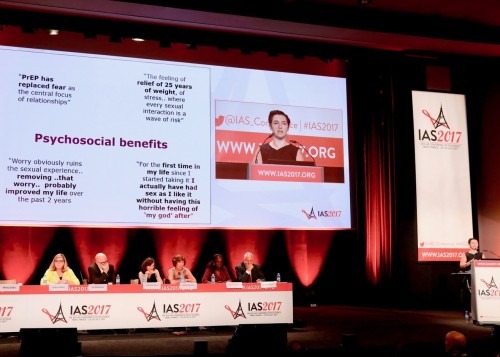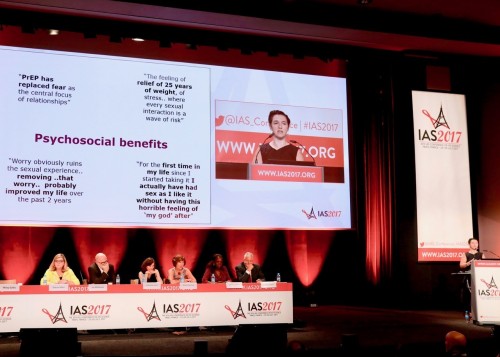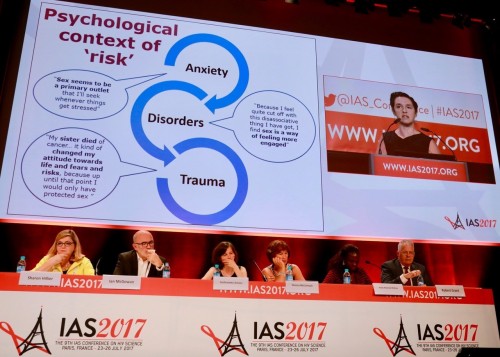When men who have sex with men (MSM) who engage in high-risk sex begin taking Truvada (tenofovir disoproxil fumarate/emtricitabine) as pre-exposure prophylaxis (PrEP), they may adjust their complex personal HIV risk reduction rules rather than replace those strategies wholesale. In other words, to presume that high-risk MSM who go on PrEP abandon condoms entirely is likely a vast oversimplification of preventive Truvada’s effect on sexual behaviors. Some high-risk men reported that starting PrEP does not change their sexual patterns at all.
British MSM on PrEP in a recent study also reported a wide variety of psychosocial benefits to using Truvada for prevention.
Mitzy Gafos, MsC, PhD, who at the time of the study was a senior social scientist at University College London (UCL) in the United Kingdom presented findings from a new qualitative analysis of the British PROUD study of PrEP at the 9th International AIDS Society Conference on HIV Science in Paris (IAS 2017).

Mitzy Gafos, MsC, PhD, describes to attendees of IAS 2017 in Paris the implications of her work on the PROUD PrEP study of MSM in the U.K. Courtesy of Benjamin Ryan
Five years since PrEP was first approved for use in the United States and seven years since the first study about the HIV prevention method was published, the effects of starting Truvada on the sexual behaviors of HIV-negative MSM remain hazy in the scientific literature. The major clinical trials of PrEP generally did not yield evidence that starting Truvada was associated with increased sexual risk-taking or increased rates of sexually transmitted infections (STIs) among MSM. Such findings typically stand in contrast with the anecdotal experiences of MSM living in areas where PrEP is popular.
One major difference between clinical trials of PrEP and its use in the real world is that such studies required that participants already be at high risk of contracting HIV before entering the study; on the other hand, at least some individuals seeking Truvada for prevention in everyday settings may not start the HIV prevention pill with as high a level of sexual risk-taking. A theoretical population of MSM who initiate PrEP with a more moderate or even low level of HIV risk may have more wiggle room to adapt their sexual behaviors after going on Truvada compared with a high-risk group.
Determining PrEP’s effect on sexual risk-taking is a complicated endeavor that requires parsing numerous factors, including long-declining rates of condom use among MSM, already-rising STI rates among MSM and the routine STI testing recommended as a component of a PrEP prescription, which may help drive up STI diagnoses.
One U.S.-based long-term study presented at the Paris conference found that men who went on PrEP during the study reported greater rates of condomless sex while on Truvada, with a particular rise in the rate of condomless sex with HIV-positive partners.
A French trial of a nondaily dosing PrEP protocol noted a decline in reported condom use among MSM when they switched from the placebo to the open-label phase of the study (when participants knew they were all receiving Truvada).

In the French IPERGAY study, there was a statistically significant rise in the rate of reported condomless sex between the placebo phase and open-label phase of the study. “Pts” = patients, or participants; “M” = month of the study.
More recently, real-world data has begun to suggest that there is a connection between starting PrEP and risk compensation, in which HIV-negative MSM increase their number of sexual partners after going on Truvada or engage in sexual practices they would not have previously. Prominent researchers are starting to acknowledge that PrEP plays a role in increased sexual risk-taking in the MSM community but state that it is not necessarily a major driver of such behavioral changes.
Seeking to understand the nuances of sexual risk-taking practices in the context of PrEP as well as the psychosocial impact of using Truvada for prevention, researchers from the PROUD study, which ran in the United Kingdom from November 2012 to November 2016, conducted semi-structured in-depth interviews of 41 HIV-negative MSM participants.
In the PROUD trial, which was designed to be as representative of real-world PrEP use as possible, participants at high risk for HIV were randomized to receive daily Truvada immediately or on a deferred basis. Giving PrEP to these men proved so effective that the deferred arm was canceled early (the participants turned out to be at much higher risk for HIV than the study authors had anticipated) and all the participants were offered Truvada. In 2015, the investigators reported that PrEP was associated with an 86 percent HIV risk reduction among those given Truvada. This finding provided a major boost to the international public health community’s faith in PrEP as an effective tool to reduce HIV transmission on a grand scale.
For the in-depth interviews reported at IAS 2017, the PROUD investigators selected some participants who reported high adherence to PrEP and others who reported low adherence, as well as men who reported increased sexual risk-taking and others who reported no such change. Thus, the population they selected was not necessarily a representative sample of the overall study group but was intentionally curated so that it would likely demonstrate varying points of view and sexual behaviors.
Most participants reported that prior to starting PrEP, they followed various sexual risk reduction strategies to avoid contracting HIV, including using condoms occasionally, strategic positioning and serosorting.
Strategic positioning involves choosing certain sexual positions over others to minimize the risk of HIV transmission, such as an HIV-negative individual favoring insertive sex (being the top) over receptive sex (being the bottom), as the latter is vastly more risky for contracting the virus. Serosorting means selecting partners based on their perceived HIV status in hopes of avoiding transmission of the virus. This latter method can backfire, since, for example, people who claim to be HIV negative may have unknowingly contracted the virus recently and therefore have a very high viral load, rendering them especially infectious.
Other sexual risk reduction nuances men reported included using condoms for one-night stands or not being the receptive partner for sex outside a relationship.
The men typically reported that when they started PrEP they folded this new factor into their existing set of personal rules for sexual risk reduction. Some reported relaxing their rules accordingly—for example, by having more receptive intercourse or having a higher rate of condomless intercourse.
Some men insisted that starting PrEP had not caused them to change their sexual risk-taking rules.
On an emotional level, participants described PrEP as a “security blanket” and an added “defense mechanism,” using such analogies as a bicycle “crash helmet” to define Truvada’s purpose in their minds. Participants reported that PrEP improved their feelings of intimacy with partners and provided “reassurance” and “added control.” The emotional benefits could also extend to participants’ HIV-positive partners, assuaging their anxieties about transmitting the virus.

Mitzy Gafos, MsC, PhD, describes to attendees of IAS 2017 in Paris the implications of her work on the PROUD PrEP study of MSM in the U.K. Courtesy of Benjamin Ryan
“People also talked about PrEP allowing them to for the first time to have the sex they desired without having this horrible feeling of ‘My God’ after sex,” Gafos said at the IAS conference.

Mitzy Gafos, MsC, PhD, describes to attendees of IAS 2017 in Paris the implications of her work on the PROUD PrEP study of MSM in the U.K. Courtesy of Benjamin Ryan
Men gave voice to a concept known in the PrEP research and advocacy community as “seasons of risk,” stating that they did not view taking Truvada for prevention as a permanent facet of their lives but rather one that suited them in the present.
According to Gafos, “They thought that the social context would change” with regard to factors affecting their ongoing need for PrEP. “So they would get bored of the wild sex scene or would age out of group sex.”
Responding to a question from a conference attendee about how PrEP may affect changes in condom use or sexually transmitted infection (STI) rates, Gafos replied, “What we can say from our data is that we didn’t see any increases in STIs overall within the study. But I think this is one of those points that’s going to be an ongoing question as we roll out PrEP.”

Courtesy of Benjamin Ryan
Benjamin Ryan is POZ’s editor at large, responsible for HIV science reporting. His work has also appeared in The New York Times, New York, The Nation, The Atlantic and The Marshall Project. Follow him on Facebook, Twitter and on his website, benryan.net.







Comments
Comments